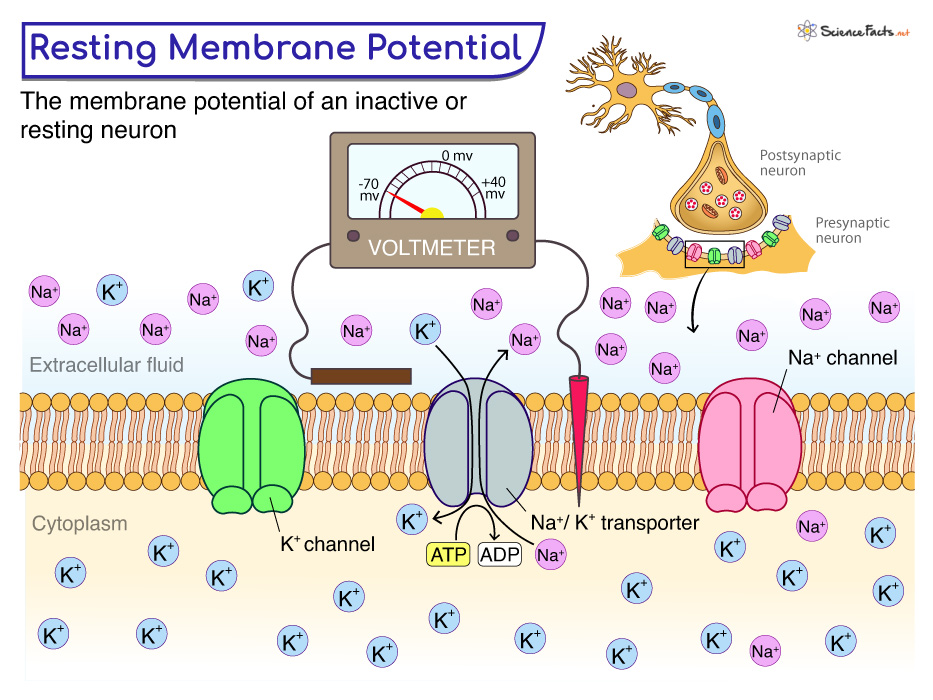The cell’s interior is negatively charged in most resting neurons compared to the exterior. The potential difference across the membrane is about 50 to 75 mV. Therefore, the RMP of a neuron is usually between -50 mV and -75 mV and is typically -70 mV. In a cell where the RMP is equal to the equilibrium potential when the rate at which ions leave the cell is the same as the rate at which ions enter the cell, the RMP is calculated using the Nernst equation: Here, Vm = equilibrium potential for any ion [V]; z = valence of the ion, [C]0 = concentration of ion X outside of the cell [mol]; [C]i = concentration of ion X inside the cell. When the membrane potential becomes more positive than the resting potential, the membrane is depolarized. In contrast, if the membrane potential is more negative than the resting potential, the membrane is hyperpolarized.
How is the Resting Membrane Potential Formed
How is the Resting Membrane Potential Maintained
The Importance of Resting Membrane Potential
- Concentration Gradients: The concentration of ions is not the same inside and outside of the cell. For example, potassium ions (K+) concentration is much higher inside the cell than outside. In comparison, sodium ions (Na+) concentration is much higher outside the cell. These concentration gradients create a force that pushes K+ ions out of the cell and Na+ ions into the cell.
- Membrane Permeability: The membrane is not equally permeable to all ions. It is much more permeable to K+ ions than Na+ ions, which means K+ ions can move across the membrane more easily than Na+ ions. Combining the concentration gradients and the membrane permeability creates a situation where K+ ions move out of the cell and Na+ ions move into the cell. However, the membrane is not wholly permeable to either ion, so the movement of ions is not entirely free. It creates a voltage difference across the membrane, and thus the RMS of a cell is negatively charged.
1. The Action of Sodium-Potassium Pump
The sodium-potassium pump, or Na+/K+ ATPase, pumps sodium ions (Na+) out and potassium ions (K+) into the cell against their concentration gradients. These pumps prevent the equalization of ion concentrations across the membrane by pumping three Na+ out for every two K+ pumped in. As a result, the electrochemical gradient is maintained, contributing to the stability of RMP. If more potassium channels are open, they will allow more K+ to cross the cell membrane, and the cell will hyperpolarize. However, the opening of additional Na+ channels will make the cell depolarize.
2. The Action of Potassium Leak Channels
Leak channels are always open, providing a continuous but small leakage of ions across the cell membrane. The most prominent leak channels involved in RMP are potassium leak channels (K+). These channels help the passive movement of K+ out of the cell, thus contributing to the negative charge inside the cell.
3. Other Ion Channels
Besides potassium and sodium channels, other ion channels, such as chloride (Cl–) channels, calcium (Ca2+) channels, and organic anion channels, also contribute to RMP. Though functions similar to sodium-potassium, these channels have varying permeabilities and thus influence the overall charge distribution across the cell membrane.
4. Selective Permeability
The plasma membrane has higher permeability to potassium ions (K+) than other ions at rest. This higher permeability allows potassium ions to leak out of the cell more readily, maintaining the RMP. In contrast, the permeability of the membrane to sodium ions (Na+) is lower at rest, limiting their contribution to RMP.
5. Regulatory Processes
Various regulatory processes help maintain RMP within a narrow range. For example, the opening or closing of ion channels in response to extracellular and intracellular factors, such as neurotransmitters, hormones, pH levels, and temperature, helps maintain the stability of RMP and prevents excessive depolarization or hyperpolarization. Thus, the resting membrane potential is actively maintained through ion pumps, leak channels, ionic concentration gradients, other ion channels, and regulatory processes.
Generation of Action Potentials
Action potentials, brief electrical impulses, are generated when the resting membrane potential reaches a threshold value. These action potentials are essential for transmitting signals along neurons, leading to sensory perception, muscle contraction, and other cellular activities.
Transmission of Nerve Impulse
RMP allows cells to generate and transmit electrical signals, enabling intercellular communication and coordination. It is crucial in excitable cells like neurons and muscle cells.
Helps in Muscle Contraction
RMP is essential for the contraction of muscle cells. In skeletal muscle, action potentials at the neuromuscular junction propagate along the muscle fibers, releasing calcium ions from the sarcoplasmic reticulum. In turn, it triggers a series of events that result in muscle contraction.
Enables Cell Signaling and Communication
RMP enables cells to generate and transmit electrical signals, facilitating intercellular communication. Neurons, for instance, rely on resting membrane potential to receive, integrate, and transmit signals. The electrical impulses generated by action potentials are crucial for transmitting information between neurons.
Maintains Cellular Homeostasis
RMP regulates the balance of ions and the distribution of electrical charges inside and outside the cell. This balance is essential for proper cellular functions, including regulating osmotic pressure, controlling pH levels, and facilitating ion transport across the membrane. For example, the RMP is essential for transmitting nerve signals in neurons. When a neuron is stimulated, the RMP changes, which allows the neuron to send a signal to another neuron. In addition, the RMP is essential for cell secretion.
